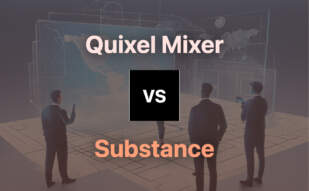Key Differences Between Quixel and Poliigon
- Pricing: Quixel starts at $19/month with a free version available, while Poliigon’s pricing is disclosed on request with options running at $17/month or $170/year.
- Licensing: Quixel’s licensing can be complex, necessitating a paid subscription for Unreal Engine final destination use. Poliigon’s licensing varies per asset with accusations of changing T&C unnoticed.
- Resources: Quixel sports a vast 3D block library with dynamic scanning. Poliigon provides ultra-high-resolution textures, PBR materials, and maps.
- Integration: Quixel’s Unreal Engine license holders get unlimited Megascans access, while Poliigon flaunts connectivity for Blender and other 3D software.
Quixel, with its comprehensive 3D asset library and integration with Unreal Engine, is the go-to for demanding AAA and VFX studios. Poliigon reigns supreme for CG artists needing high-resolution textures and PBR materials.

| Comparison | Quixel | Poliigon |
|---|---|---|
| Proprietary Technologies | Megascans, Bridge, Mixer | Texture library with unique textures, PBR materials |
| Ease of Use | Intuitive graphical UI, easy-to-use tools | Non-reliance on third-party software, integrated map control |
| Unique Features | Smart materials, Screen-space masking, Brush presets | Overlays, Ultra-high resolution textures up to 24K |
| Content | Vast library of 3D building blocks, 2D, 3D, textures, brushes | Large collection of 3D models, textures, materials, HDRIs |
| Pricing | Begins at $19 per month | Subscription at $17 per month or $170 per year |
| Client Base | AAA, VFX studios | CG artists, supports Arnold, Corona, OctaneRender, Redshift, and V-Ray |
| Asset Usage Policy | Complex licensing, requires paid subscription for use in Unreal Engine | Varying licensing and system requirements per asset |
| Additional Info | Facilitates augmented reality usage | Versioning system for textures set to powers of two, customizable textures |
What Is Quixel and Who’s It For?
Quixel is a revolutionary tech company founded in 2011 in Sweden by Teddy Bergsman and Waqar Azim, aimed at rapid digital environment creation. The company offers a vast repository of 3D building blocks, including tools like Megascans, Bridge, and Mixer. Quixel caters to creative minds in AAA and VFX studios intending to speed up their art production.
The company produces Bforartists, an intuitive user-friendly graphical UI based on Blender, an open-source 3D software. Integrated into the suite is Forger, an innovative tool for 3D model creation ideal for game development and film making. The pricing is pocket-friendly, set at $19 per month with a free version available.

Pros of Quixel
- Vast library of 3D building blocks, including 2D, 3D, textures, brushes
- User-friendly UI with easy-to-use tools
- Affordable pricing with free version availability
- Supports augmented reality usage
Cons of Quixel
- Complex licensing, requires paid subscription if working models within Unreal Engine
- Static renders in Blender
What Is Poliigon and Who’s It For?
Poliigon is a leading tech company specializing in the provision of unique textures and designs by CG artists. The platform provides over 1000 PBR materials for accurate shaders, apt for designers and developers seeking authentic photorealistic materials. Additional features such as integrated map control for materials contribute towards Poliigon’s strength in the market.
The company’s offerings extend to hand-drawn repeating patterns ideal for architectural and sci-fi scenes. Subscriptions are available at $17 per month, or $170 annually, with users standing a chance to win a full year’s subscription through monthly competitions.

Pros of Poliigon
- Large collection of photorealistic materials
- Ultra-sharp and high-resolution textures
- Includes unique asset: overlays for adding touches of wear and tear
- Market competitive subscription packages
Cons of Poliigon
- Pricing not immediately disclosed
- Increased competition from AI
- Unexpected changes in terms and conditions
- Textures’ resolutions set to powers of two can be restrictive
Quixel vs Poliigon: Pricing
Quixel starts at $19 per month with a free version available, while Poliigon costs $17 per month or $170 annually.
Quixel
Quixel’s pricing commences at $19 per month, providing a cost-effective solution for 3D artists. Along with its paid subscriptions, Quixel also offers a free tier that allows access to its resources limited by volume restrictions. Those with an Unreal Engine license benefit from unlimited access to Megascans, thereby necessitating a paid subscription only for other applications.
Poliigon
Poliigon has structured its pricing model to be straightforward yet flexible, starting at $17 per month or $170 annually. Offering a consistently updated library of high-resolution textures and PBR materials, the cost of a Poliigon subscription allows for perpetual access to their vast texture library. The exact pricing details, however, are only disclosed upon personal request, and may vary depending on specific needs and scale of usage.
Quixel or Poliigon: Which Serves Your Needs?
In the face-off between Quixel and Poliigon, the discerning choice boils down to your unique requirements. Here’s our audience-specific guidance:
Developers Building Complex Digital Environments
With Quixel, speed and flexibility take precedence. Produce extraordinary 3D art with Megascans, Bridge, Mixer. For Unreal Engine users, enjoy untrammeled access to Megascans. Quixel’s vast repertoire is continually replenished to inspire creativity. The hitch- prepare yourself to navigate complex licensing.

VFX Studios, AAA Game Makers
Quixel’s impressive clientele unveils its mettle. Its complete 3D suite Bforartists, forks of open-sourced Blender, unclutters and streamlines your design journey. The byproduct, notable features such as Forger, unlock the benefits of a rich tool range and multi-touch interface, paving the way for quality VFX and gaming experiences.

CG Artists, Architectural and Sci-Fi Scene Creators
If you are seeking extraordinary, ultra-specific textures that can perfectly accentuate your architectural or sci-fi scenes, Poliigon fills the bill. Count on the breathtaking range of 1000+ PBR materials and unique high-resolution textures that can be precisely amplified with map control. Overlays add a realistic touch. But stay vigilant about licensing conditions.

Ambitioning game-changers get powered by Quixel for flexible, quality 3D art creation. In comparison, Poliigon fuels CG, architectural & sci-fi creators with its exquisite, high-resolution textures, and PBR materials.
Hannah Stewart
Content writer @ Aircada, tech enthusiast, metaverse explorer, and coffee addict. Weaving stories in digital realms.





